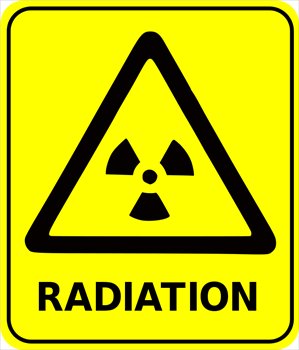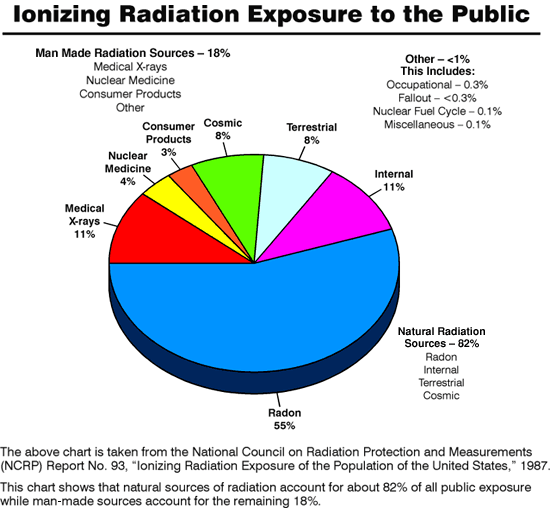How a silent killer may be closer to home than you think.
Posted by Alexandru Nicolae
Radon is a naturally occurring radioactive substance (it's even in the periodic table of elements). It is an odorless, tasteless gas that is produced as Uranium decays over several million years. It also occurs naturally in some rocks and has been around since the planet formed;therefore, the radon gas it produces can accumulate in some areas, particularly confined spaces such as offices or basements. Because of this, radon accounts for the second largest exposure of radiation to the general public, over 55% of the natural background radiation, right after medical imaging (X-rays, CT scans...), Internal forms such as food, and cosmic rays. Nuclear power plants and nuclear weapons account for a distant last. The US Environmental Protection Agency (USEPA)has even provided safety limits for the level of radon allowable in a household, so you know this is serious stuff not to be taken lightly. So if so many people are exposed to this stuff, why don't we see its effects very often?
The simple answer: you do! In fact, it has been identified as the second leading cause of lung cancer after smoking, causing a whopping 10% of the reported annual cancer incidences. To put this in perspective, that's anywhere between 7,000 to 30,000 of the approximately 230,000 new cases of lung cancer reported every year in the US. Cancer in general causes 23% of the reported annual deaths in the United States alone, the large majority of these being lung and breast cancer (if you haven't stopped smoking by now, please stop). And for one more scary statistic, just because I can throw it out there. From birth to death, you have a lovely 1 in 2 chance of developing some form of cancer (1 in 3 if you're female); for lung cancer the rates are about 1 in 13 for males and 1 in 16 for females. If you play the lottery, you'll notice that even the best odds of winning never go below 1 in 1000 chance of winning, yikes.
How does this radioactive gas cause so much of the observed lung cancers every year? Radon is quite a heavy gas, in fact it's the heaviest gas there is. It also has the ability to bind to dust particles which we all breathe in on a regular basis (moreso if your house is particularly dusty). Once these particles make it into the small passages of your respiratory tract they sit there, still decaying, still releasing lots of high energy radiation into your lung tissue. These high energy particles cause damage to the epithelial cells of the lungs and consequently your DNA. This can lead to mutations in the genetic code,leading directly to cancer. And because the lung tissue is what is being bombarded with radiation, the most common form of cancer developed is lung cancer.
Now that you know you may be at risk, what can you do about it? The answer, is nothing. Radon has been around for a very long time and unfortunately is a part of the natural background radiation we receive on a daily basis, along with UV rays from the sun and radiation from certain foods we eat. That's right, radioactive potassium is present in some of the foods we eat like bananas, although in extremely small quantities.
But back to the radon. There are radon detectors which can sometimes be installed in homes that are susceptible to high concentrations of radon. These usually come pre-installed into homes that have been shown to already have large amounts of radon present. But besides that, there isn't much you can do besides limiting how long you stay in basements, and sometimes that's just not feasible (how else would I play Starcraft if not for a poorly lit, poorly ventilated basement). We all have to get used to the fact that even by living in a house and entering a basement, we're playing a lottery with cancer as the grand prize, it's simply part of the riskiness of everyday life; you take the same risk when driving your car to work. Although, this is one lottery I hope I never win, or am even remotely lucky in.
References
Brooks AL, Bao S, Harwood PW, et al. (1997). Induction of micronuclei in respiratory tract following radon inhalation. Int J Radiat Biol;72(5):485-495.
Monchaux G, Morlier JP, Altmeyer S, et al. (1999). Inlfluence of Exposure Rate on Lung Cancer Induction in Rats Exposed to Radon Progeny. Rad Res; 152:S137-S140.
Pershagen G, Akerblom G, Axelson O, et al. (1994) Residential Radon Exposure and Lung Cancer in Sweden. N Engl J Med;330:159-164.
Jermal AJ, Siegal R, Ward E, et al. (2009). Cancer Statistics, 2009. Amer Canc Soc, Can J Clin;59(4):225-249.



No comments:
Post a Comment